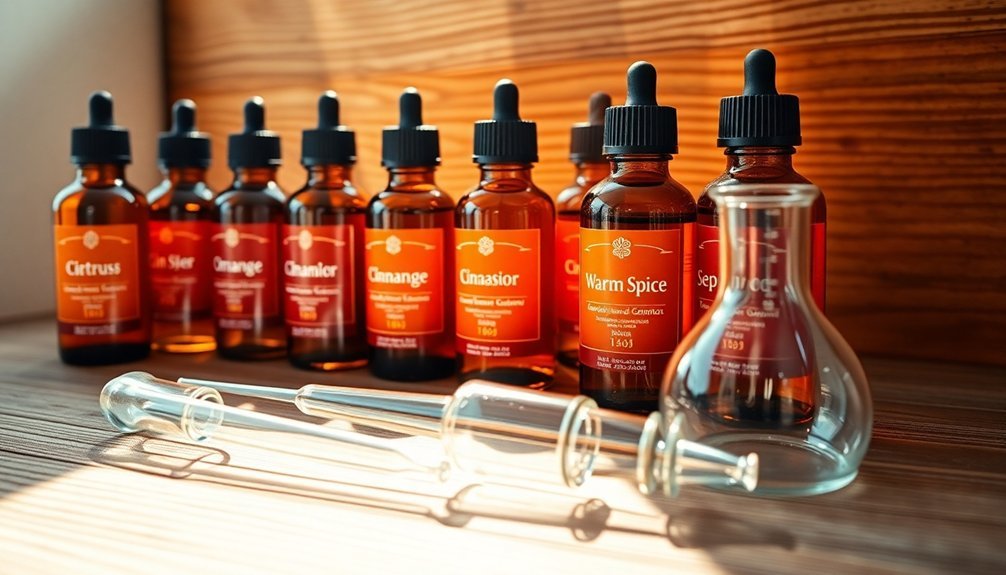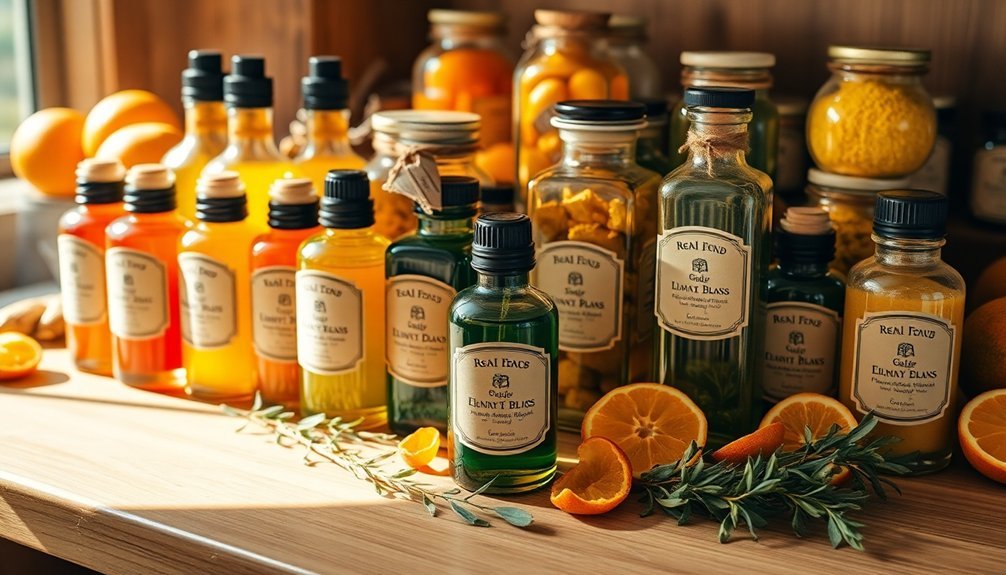Create your own luxurious citrus-spice perfumes with these top five essential oil blends: lemon-lime with cinnamon and neroli for spring freshness, grapefruit-bergamot with pink pepper for summer vibes, mandarin-orange with nutmeg for autumn warmth, bergamot-lemon with rosemary for winter energy, and lime-orange with basil for seasonal shifts. You'll need to follow specific ratios (30% citrus, 50% middle notes, 20% spice base notes) to achieve the perfect balance. Discover how to blend, store, and wear these aromatic combinations for lasting fragrance.
Creating Your Signature Citrus-Spice Blend

Whether you're new to essential oils or an experienced aromatherapist, creating your own citrus-spice perfume blend lets you craft a unique signature scent that energizes and grounds you.
Start by selecting your citrus base – sweet orange and bergamot offer uplifting notes, while mandarin provides a gentler touch. These oils are particularly effective since they're derived from fruit rinds. Add depth with spices like black pepper or cardamom, following the 30/50/20 rule for a balanced composition.
Mix your oils in a clean glass beaker, beginning with 30% citrus oils as top notes, then incorporate 50% middle notes like geranium, and finish with 20% spicy base notes.
You'll want to store your creation in a dark glass bottle in a cool place to preserve its potency. Test small amounts first, as you can always adjust the ratios to suit your preferences.
Essential Ingredients for Perfect Citrus-Spice Harmony
Four essential categories of oils form the foundation of any successful citrus-spice perfume blend.
You'll need citrus oils like bergamot, lemon, or grapefruit to create bright, fresh top notes. Spice oils, including cinnamon, clove, and ginger, provide warmth and depth to your blend's heart notes.
To achieve perfect harmony, incorporate herbal and floral complementaries such as lemongrass or jasmine, which bridge the gap between citrus brightness and spicy warmth. These middle notes help your blend shift smoothly from top to bottom notes. Drawing from ancient perfumery traditions, the combination of citrus and spice notes has been cherished since Egyptian times.
Finally, you'll want to anchor your creation with carrier and base notes. Consider jojoba oil as your carrier, while sandalwood or vanilla can provide a lasting foundation that grounds your entire composition.
Blending Ratios and Proportions for Lasting Scents

Creating a long-lasting citrus-spice perfume blend requires careful attention to proportions and ratios between different essential oil categories. You'll want to balance the quick-evaporating citrus oils with longer-lasting spice notes for a harmonious scent that evolves beautifully over time. Since individual preferences vary based on personal experiences, consider testing different ratios to find your perfect blend.
| Oil Type | Recommended Drops |
|---|---|
| Citrus (Top) | 3 drops |
| Spice (Middle) | 5 drops |
| Woody (Base) | 2 drops |
| Herbaceous (Middle) | 3 drops |
| Carrier Oil | 15 drops |
Start with a 10-drop blend using the 30-50-20 ratio: 30% citrus oils as top notes, 50% spice and herbaceous oils as middle notes, and 20% woody oils as base notes. Test your blend on perfume strips and let it rest for 24 hours before making adjustments. You can scale these proportions up while maintaining the same ratios.
Seasonal Citrus-Spice Combinations That Inspire
Throughout the year, nature's rhythms inspire unique and enchanting citrus-spice combinations that perfectly complement each season's mood and energy.
You'll find that spring embraces lemon and lime with gentle cinnamon, while summer celebrates grapefruit and bergamot paired with peppery notes.
As autumn arrives, warm mandarin and sweet orange blend beautifully with nutmeg and ginger, creating cozy atmospheres.
Winter changes feature zesty citrus notes balanced with rosemary and thyme for uplifting effects.
Choose your seasonal blend from these inspiring combinations:
- Spring: Lemon-lime with cinnamon and neroli for a sophisticated refresh
- Summer: Grapefruit-bergamot with pink pepper and cedar for beachy vibes
- Autumn: Mandarin-orange with nutmeg and sandalwood for cozy comfort
- Winter: Bergamot-lemon with rosemary and thyme for energizing warmth
- Changing: Lime-orange with basil and cedar for seasonal shifts
Storing and Wearing Your Custom Perfume Blends

Proper storage and application techniques can greatly extend the life of your custom citrus-spice perfume blends. Store your creations in dark glass or amber bottles, keeping them away from direct sunlight and heat. You'll want to let your blend mature for 48 hours to 6 weeks, allowing the citrus and spice notes to meld perfectly.
| Storage Tips | Container Choices | Application Methods |
|---|---|---|
| Use dark glass | Amber bottles | Apply to pulse points |
| Keep cool & dark | Tight-fitting caps | Layer with lotion |
| Avoid sunlight | Quality spray nozzles | Mist from distance |
| No plastic | Roll-on options | Multiple light applications |
| Record recipes | Size-appropriate vessels | Apply to moisturized skin |
To enjoy your blend's full potential, apply it to moisturized skin at pulse points. For longer-lasting fragrance, layer your perfume with unscented lotion or lightly mist your hair.
Frequently Asked Questions
Can Citrus-Spice Perfume Blends Stain Clothing or Jewelry?
Yes, you'll need to be careful as citrus and spice essential oils can stain your clothes and jewelry. They're highly concentrated, so it's best to dilute them and avoid direct contact with fabrics.
How Do Hormonal Changes Affect the Way Citrus-Spice Perfumes Smell?
Your hormonal fluctuations can dramatically change how citrus-spice scents smell to you. When estrogen levels shift, you'll notice these fragrances may seem stronger or weaker than usual during different hormonal phases.
Are Citrus-Spice Perfume Blends Safe to Wear During Pregnancy?
You'll need to be cautious with citrus-spice perfumes during pregnancy. Avoid them in your first trimester, and always check with your doctor. Some spices like cinnamon and nutmeg aren't safe for pregnant women.
Can Citrus-Spice Perfumes Trigger Allergic Reactions in Sensitive Individuals?
Yes, you can experience allergic reactions to citrus-spice perfumes if you're sensitive to ingredients like limonene, linalool, or bergapten. These compounds can cause skin irritation, hives, dermatitis, and even phototoxic reactions.
Do Citrus-Spice Perfumes Interact With Prescription Medications When Applied to Skin?
When properly diluted, your citrus-spice perfumes won't typically interact with medications through skin application. However, you should space out topical applications from taking medications by 2-3 hours as a precaution.
In Summary
You've now got everything you need to craft beautiful citrus and spice perfume blends that'll turn heads and lift spirits. Don't be afraid to experiment with different combinations while following the basic blending guidelines. Remember to store your creations properly in dark glass bottles and apply them to pulse points for the best effect. Your signature scent awaits – start mixing your perfect blend today.
References
- https://www.candlewarmers.com/products/citrus-boost-essential-oil-blend/
- https://essentialsbycatalina.com/product/citrus-spice-tea-pure-e-o-blend/
- https://www.lovingessentialoils.com/blogs/essential-oil-tips/12-benefits-of-citrus-essential-oils
- https://dokumen.pub/the-citron-compendium-the-citron-etrog-citrus-medica-l-science-and-tradition-303125774x-9783031257742.html
- https://butterbykeba.com/products/citrus-spice-perfume-oil-duo
- https://gyalabs.com/blogs/diy-recipes/citrus-sunshine-refreshing-diy-recipes
- https://www.youtube.com/watch?v=R3mhWjX60A0
- https://hiqili.com/blogs/recipes/essential-oils-for-perfume
- http://www.soap-making-resource.com/summer-citrus-essential-oil-blends.html
- https://www.freshskin.co.uk/blog/essential-oils-blending-guide/





Leave a Reply